|
Strain Name
|
C57BL/6-Cd276tm1(CD276)Bcgen/Bcgen
|
Common Name
|
B-hB7-H3 mice
|
|
Background
|
C57BL/6
|
Catalog number
|
110028
|
|
Aliases
|
4Ig-B7-H3, B7-H3, B7H3, B7RP-2
|
NCBI Gene ID
|
102657
|
mRNA expression analysis

(A) Strain specific analysis of B7-H3 gene expression in C57BL/6 and B-hB7-H3 mice by RT-PCR. Mouse B7-h3 mRNA was detectable in splenocytes of wild-type C57BL/6 mice (+/+). Human B7-H3 mRNA was detectable only in homozygous B-hB7-H3 mice (H/H), but not in wild-type mice.
(B) B7-H3 gene expression in C57BL/6 mice and B-hB7-H3 mice by RT-qPCR. Bone marrow were collected from wild-type C57BL/6 mice (+/+) and homozygous B-hB7-H3 mice (H/H), and then stimulated with GM-CSF and IL4 for 7 days. After that, the cells were stimulated with 10 μg/mL LPS for 24 h. The expression of B7-H3 in B-hB7-H3 mice was similar to that in the C57BL/6 mice at mRNA level.
Protein expression analysis
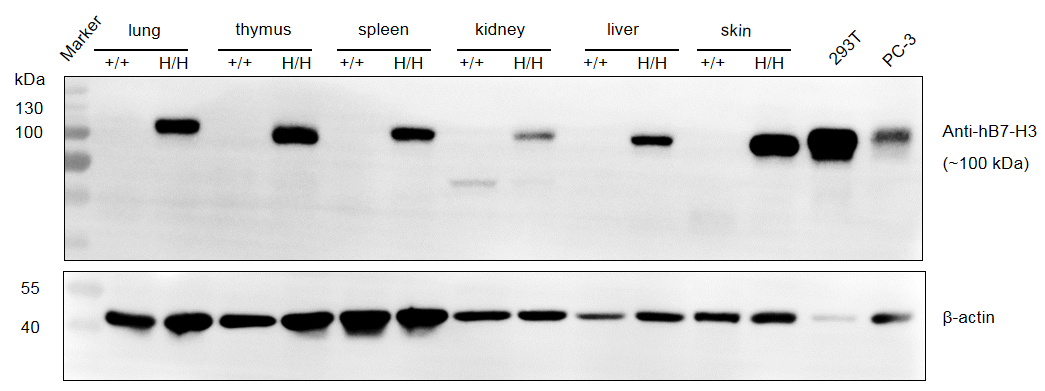
Strain specific B7-H3 expression analysis in homozygous B-hB7-H3 mice by western blot. Tissues were collected from wild-type C57BL/6 mice (+/+) and homozygous B-hB7-H3 mice (H/H), and analyzed by western blot with species-specific anti-B7-H3 antibody. Human B7-H3 was detectable in homozygous B-hB7-H3 mice but not in wild-type C57BL/6 mice.
Analysis of spleen leukocyte subpopulations in B-hB7-H3 mice
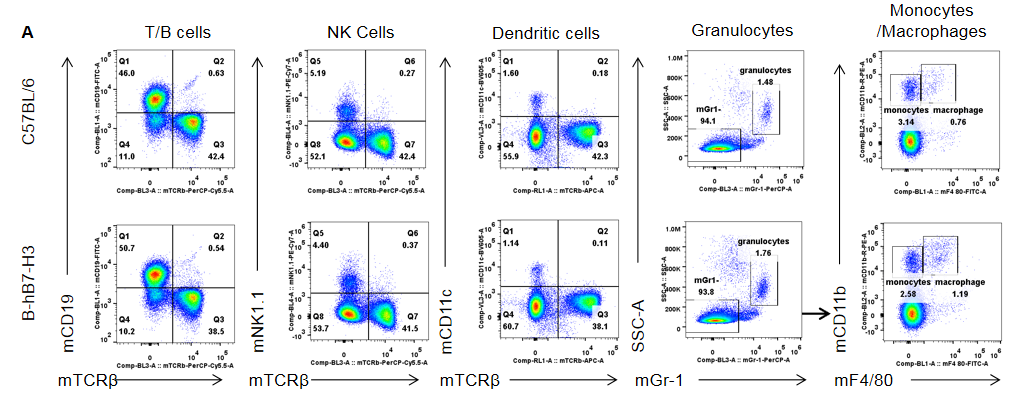
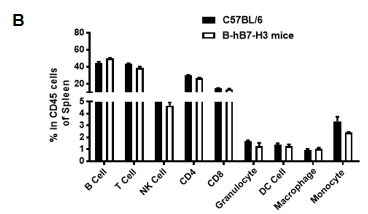
Analysis of spleen leukocyte subpopulations by FACS. Splenocytes were isolated from female C57BL/6 and B-hB7-H3 mice (n=3, 6 weeks-old) and analyzed by flow cytometry to assess leukocyte subpopulations. (A) Representative FACS plots gated on single live CD45+ cells for further analysis. (B) Results of FACS analysis. Percentages of T, B, NK cells, monocyte/macrophages, and DC cells were similar in homozygous B-hB7-H3 mice and C57BL/6 mice, demonstrating that introduction of hB7-H3 in place of its mouse counterpart does not change the overall development, differentiation, or distribution of these cell types in spleen. Values are expressed as mean ± SEM.
Analysis of spleen leukocyte subpopulations in B-hB7-H3 mice
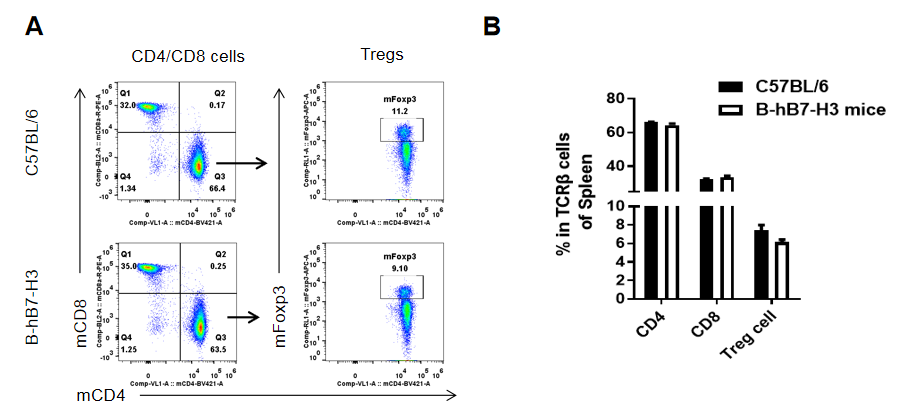
Analysis of spleen T cell subpopulations by FACS. Splenocytes were isolated from female C57BL/6 and B-hB7-H3 mice (n=3, 6 weeks-old) and analyzed by flow cytometry for T cell subsets. (A) Representative FACS plots gated on TCRβ+ T cells and further analyzed. (B) Results of FACS analysis. Percentages of CD8+, CD4+, and Treg cells were similar in homozygous B-hB7-H3 and C57BL/6 mice, demonstrating that introduction of hB7-H3 in place of its mouse counterpart does not change the overall development, differentiation or distribution of these T cell subtypes in spleen. Values are expressed as mean ± SEM.
Analysis of lymph node leukocyte subpopulations in B-hB7-H3 mice
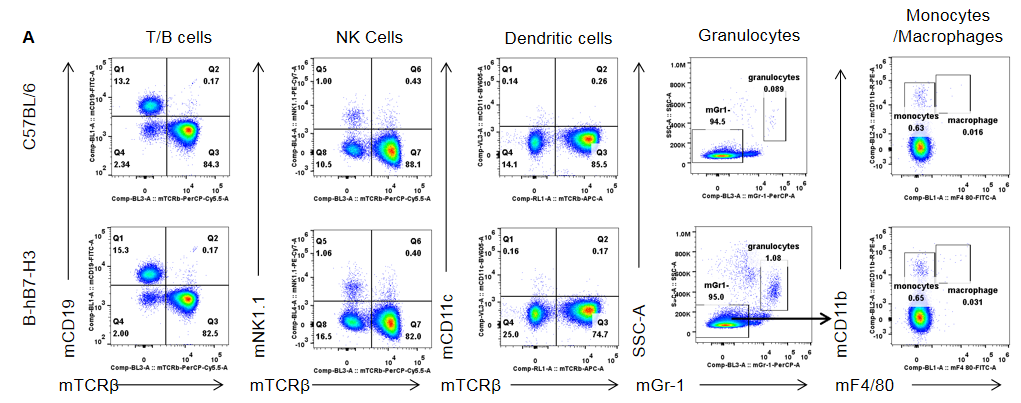
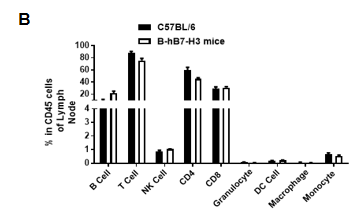
Analysis of lymph node leukocyte subpopulations by FACS. Leukocytes were isolated from female C57BL/6 and B-hB7-H3 mice (n=3, 6 week-old) Flow cytometry analysis of the leukocytes was performed to assess leukocyte subpopulations. (A) Representative FACS plots gated on single live CD45+ cells for further analysis. (B) Results of FACS analysis. Percentages of T, B and NK cells were similar in homozygous B-hB7-H3 mice and C57BL/6 mice, demonstrating that introduction of hB7-H3 in place of its mouse counterpart does not change the overall development, differentiation, or distribution of these cell types in lymph node. Values are expressed as mean ± SEM.
Analysis of lymph node T cell subpopulations in B-hB7-H3 mice
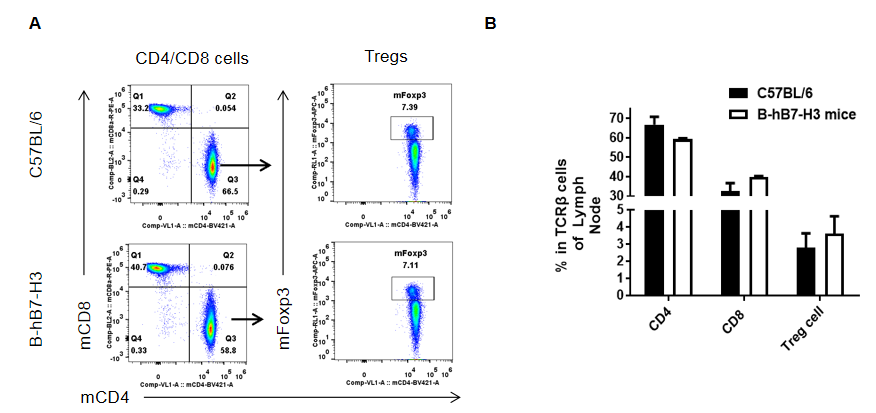
Analysis of lymph node T cell subpopulations by FACS. Leukocytes were isolated from female C57BL/6 and B-hB7-H3 mice (n=3, 6 week-old) and analyzed by flow cytometry for T cell subsets. (A) Representative FACS plots gated on TCRβ+ T cells and further analyzed. (B) Results of FACS analysis. Percentages of CD8+, CD4+, and Treg cells were similar in homozygous B-hB7-H3 mice and C57BL/6 mice, demonstrating that introduction of hB7-H3 in place of its mouse counterpart does not change the overall development, differentiation or distribution of these T cell subtypes in lymph node. Values are expressed as mean ± SEM.
Analysis of blood leukocyte subpopulations in B-hB7-H3 mice
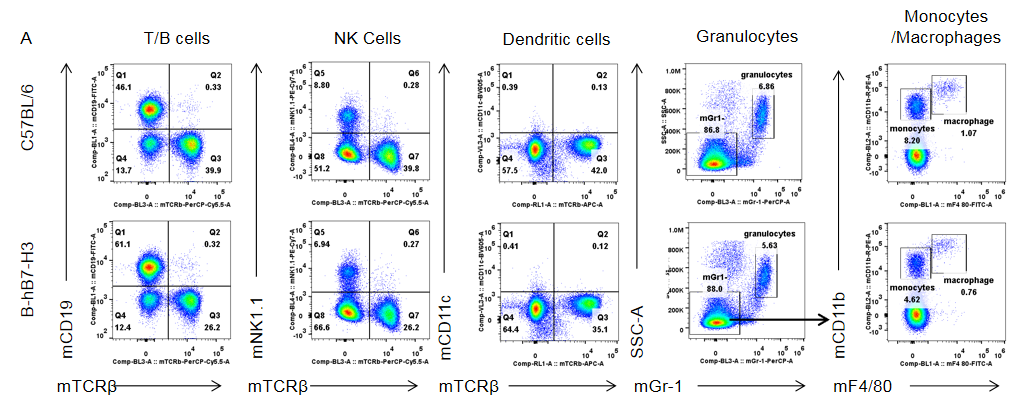
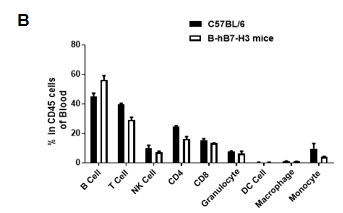
Analysis of blood leukocyte subpopulations by FACS. Blood were isolated from female C57BL/6 and B-hB7-H3 mice (n=3, 6 week-old) Flow cytometry analysis of the leukocytes was performed to assess leukocyte subpopulations. (A) Representative FACS plots gated on single live CD45+ cells for further analysis. (B) Results of FACS analysis. Percentages of T, B and NK cells were similar in homozygous B-hB7-H3 mice and C57BL/6 mice, demonstrating that introduction of hB7-H3 in place of its mouse counterpart does not change the overall development, differentiation, or distribution of these cell types in blood. Values are expressed as mean ± SEM.
Analysis of blood T cell subpopulations in B-hB7-H3 mice
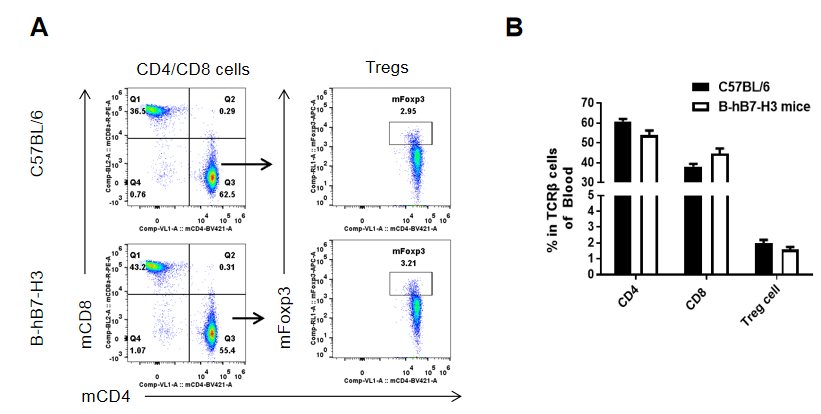
Analysis of blood T cell subpopulations by FACS. Blood were isolated from female C57BL/6 and B-hB7-H3 mice (n=3, 6 week-old) and analyzed by flow cytometry for T cell subsets. (A) Representative FACS plots gated on TCRβ+ T cells and further analyzed. (B) Results of FACS analysis. Percentages of CD8+, CD4+, and Treg cells were similar in homozygous B-hB7-H3 mice and C57BL/6 mice, demonstrating that introduction of hB7-H3 in place of its mouse counterpart does not change the overall development, differentiation or distribution of these T cell subtypes in blood. Values are expressed as mean ± SEM.
Blood routine test results
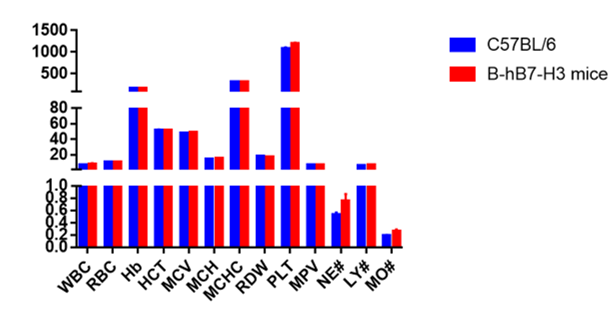
Complete blood count (CBC). Blood from C57BL/6 and B-hB7-H3 mice (n=5, 6 week-old, female) were collected and analyzed for CBC. Any measurement of B-hB7-H3 mice in the panel were similar to C57BL/6, and there was no differences between male and female mice, indicating that humanized mouse does not change blood cell composition and morphology. Values are expressed as mean ± SEM.
Blood chemistry results
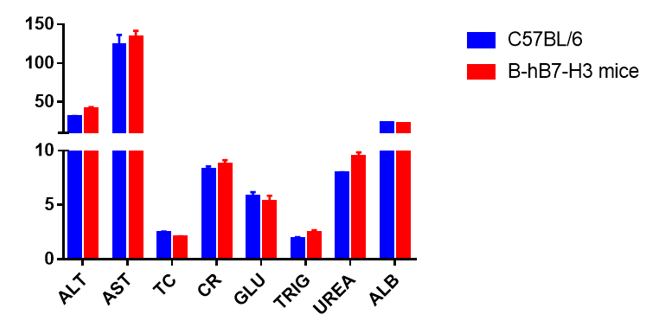
Blood chemistry tests of B-hB7-H3 mice. Serum from C57BL/6 and B-hB7-H3 mice (n=5, 6 week-old, female) were collected and analyzed for levels of ALT, AST and other indicators in the panel. There was no differences on either measurement between C57BL/6 and humanized mouse, indicating that humanized mouse does not change ALT and AST levels or health of liver. Values are expressed as mean ± SEM.
Antibody binding assay
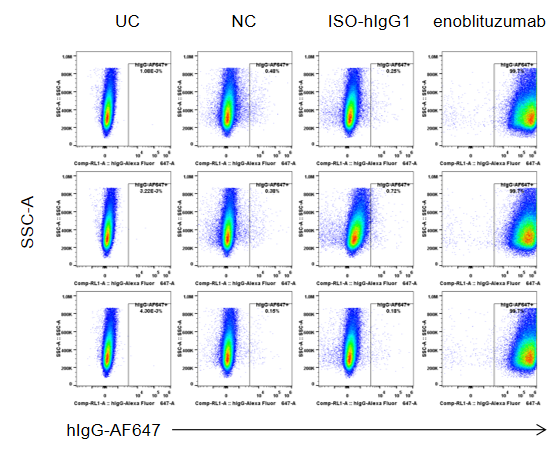
Flow cytometry analysis of the B-hB7-H3 MC38 was performed to assess anti-human B7-H3 Ab binding. Single live cells were gated and used for further analysis as indicated here. B-hB7-H3 MC38 binds well with enoblituzumab (in house) vs isotype control.
In vivo efficacy of anti-human B7-H3 antibody
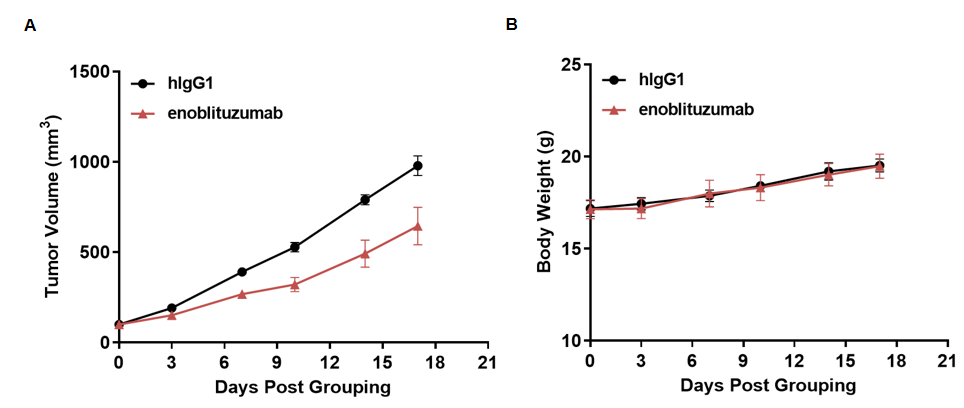
Antitumor activity of anti-human B7-H3 antibody in B-hB7-H3 mice. (A) Anti-human B7-H3 antibody inhibited hB7-H3 MC38 tumor growth in B-hB7-H3 mice. Murine colon cancer hB7-H3 MC38 cells were subcutaneously implanted into homozygous B-hB7-H3 mice (female, 6-7 week-old, n=5). Mice were grouped when tumor volume reached approximately 100 mm3, and treated with anti-hB7-H3 antibody. (B) Body weight changes during treatment. As shown in panel A, enoblituzumab (in house) was efficacious in controlling tumor growth in B-hB7-H3, demonstrating they provide a powerful preclinical model for in vivo evaluation of anti-human B7-H3 antibodies. Values are expressed as mean ± SEM.
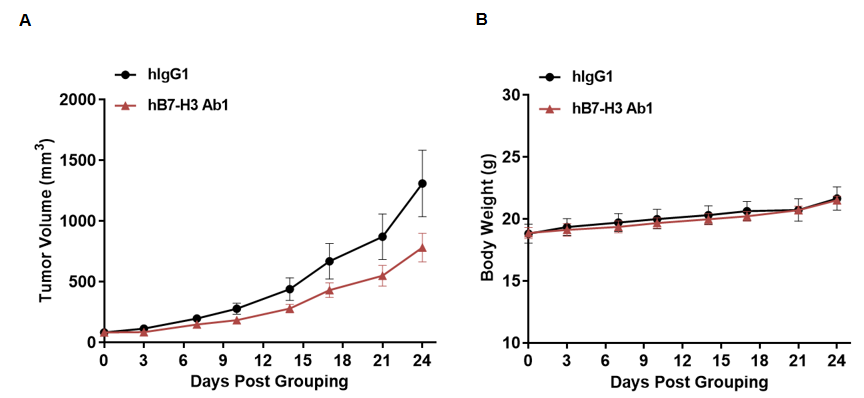
Antitumor activity of anti-human B7-H3 antibody in B-hB7-H3 mice. (A) Anti-human B7-H3 antibody inhibited hB7-H3 MC38 tumor growth in B-hB7-H3 mice. Murine colon hB7-H3 MC38 cells were subcutaneously implanted into homozygous B-hB7-H3 mice (female, 6-7 week-old, n=6). Mice were grouped when tumor volume reached approximately 80 mm3, and treated with anti-hB7-H3 antibody. (B) Body weight changes during treatment. As shown in panel A, anti-human B7-H3 antibody (in house) was efficacious in controlling tumor growth in B-hB7-H3, demonstrating they provide a powerful preclinical model for in vivo evaluation of anti-human B7-H3 antibodies. Values are expressed as mean ± SEM.
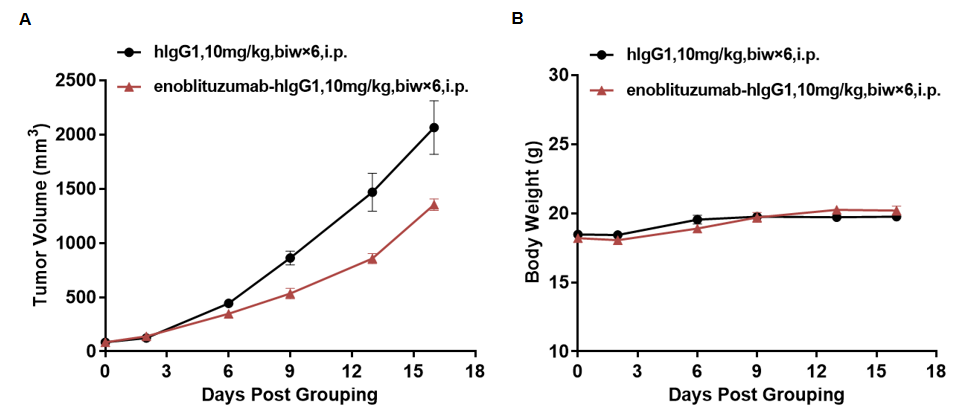
Antitumor activity of anti-human B7-H3 antibody in B-hB7-H3 mice. (A) Anti-human B7-H3 antibodies inhibited hB7-H3 EL4 tumor growth in B-hB7-H3 mice. Murine lymphoma hB7-H3 EL4 cells were subcutaneously implanted into homozygous B-hB7-H3 mice (female, 6-7 week-old, n=6). Mice were grouped when tumor volume reached approximately 80 mm3, and treated with anti-hB7-H3 antibodies at doses and schedules in panel. (B) Body weight changes during treatment. As shown in panel A, anti-human B7-H3 antibodies (in house) was efficacious in controlling tumor growth in B-hB7-H3, demonstrating they provide a powerful preclinical model for in vivo evaluation of anti-human B7-H3 antibodies. Values are expressed as mean ± SEM.
Combination therapy of enoblituzumab and anti-mouse PD-1
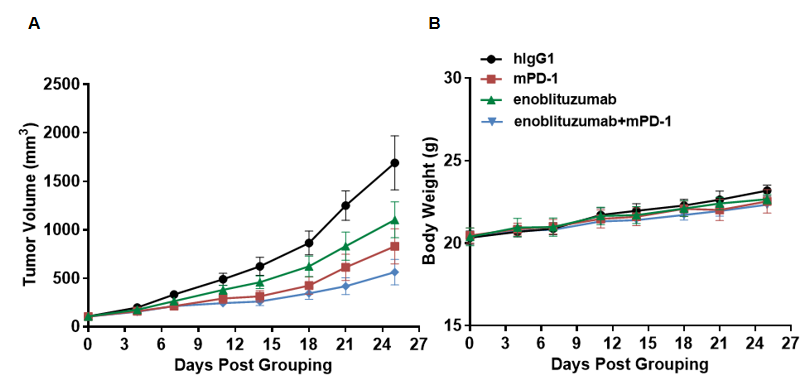
Antitumor activity of enoblituzumab and anti-mouse PD-1 in B-hB7-H3 mice. (A) Anti-human B7-H3 antibodies combined with anti-mouse PD-1 antibody inhibited MC38 tumor growth in B-hB7-H3 mice. Murine colon cancer hB7-H3 MC38 cells were subcutaneously implanted into homozygous B-hB7-H3 mice (female, 7-8 week-old, n=6). Mice were grouped when tumor volume reached approximately 100 mm3, at which time they were treated with enoblituzumab and anti-mouse PD-1 antibodies. (B) Body weight changes during treatment. As shown in panel A, combination of enoblituzumab (in house) and anti-mouse PD-1 shows more inhibitory effects than individual groups, demonstrating that the B-hB7-H3 mice provide a powerful preclinical model for in vivo evaluating combination therapy efficacy of mPD-1 antibodies and hB7-H3 antibodies. Values are expressed as mean ± SEM.


























